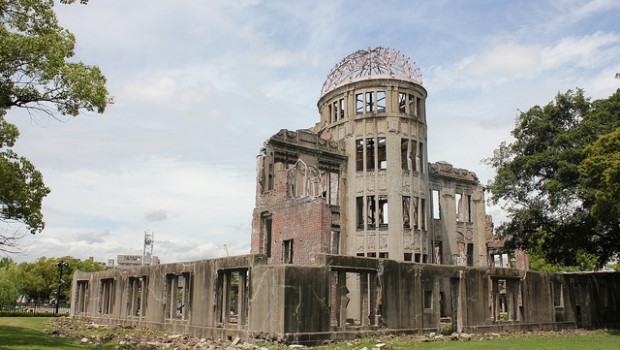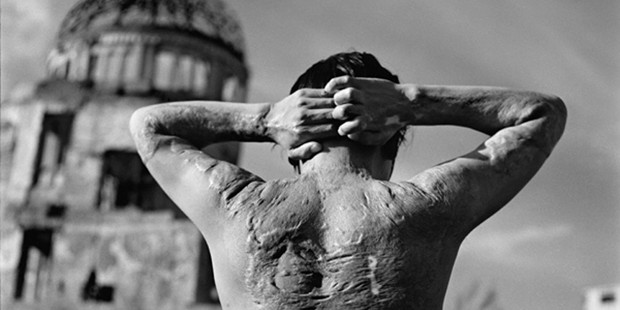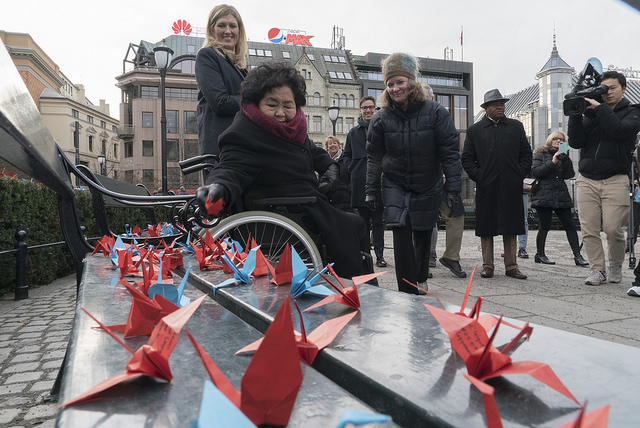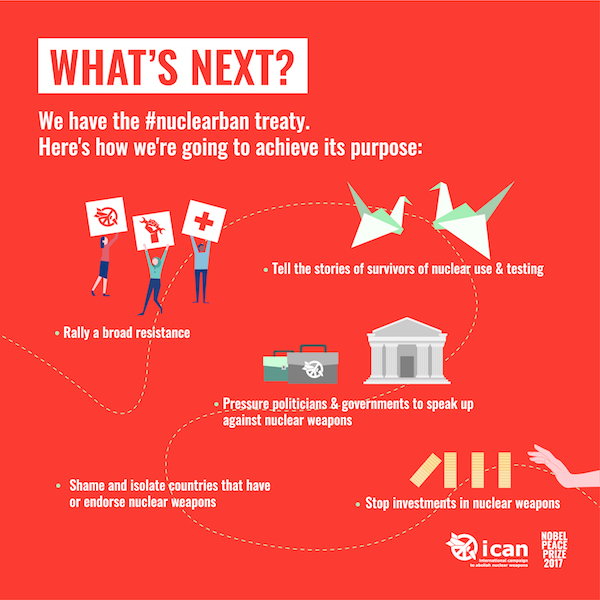Hiroshima and Nagasaki: 7 Things You Should Know
SPECIAL FEATURE, NOBEL LAUREATES, WEAPONS OF MASS DESTRUCTION, ANGLO AMERICA, ASIA--PACIFIC, MILITARISM, 6 Aug 2018
ICAN-Int’l Campaign to Abolish Nuclear Weapons – TRANSCEND Media Service
This week (6-9 Aug 2018) marks 73 years since two atomic bombs were dropped over the cities of Hiroshima and Nagasaki. Hundreds of thousands of people were killed and maimed, and the effects are still being felt today. But while the mushroom clouds became iconic symbols of mass destruction, and the paper cranes a symbol of hope for a nuclear-free world, there are many things you may not know – or may have forgotten – that are really important if we’re going to make sure this never happens again.
#1 More than 210,000 people were killed
By the end of 1945, the bombing had killed an estimated 140,000 people in Hiroshima, and a further 74,000 in Nagasaki. In the years that followed, many of the survivors would face leukemia, cancer, or other terrible side effects from the radiation.
“Each person had a name. Each person was loved by someone. Let us ensure that their deaths were not in vain.”
— Setsuko Thurlow, survivor of the August 1945 atomic bombing of Hiroshima
Nobel Peace Prize acceptance speech, December 2017
#2 The bombs were detonated in the air
Bombs don’t have to hit the ground in order to detonate. For nuclear weapons, detonating them in the air causes the blast to have a larger geographical impact. Both “Little Boy” (the uranium bomb dropped on Hiroshima) and “Fat Man” (the plutonium bomb dropped on Nagasaki) were detonated in the air. You can find out more about what impact a detonation on the air or on the ground would have on your city through the Outrider Foundation’s powerful (but terrifying) interactive tool:
https://outrider.org/nuclear-weapons/interactive/bomb-blast/
#3 First responders couldn’t help back then, and they wouldn’t be able to help now.
If a nuclear weapon were to be detonated over a city today, first responders – hospitals, firemen, aid organisations – would simply be unable to help. This powerful video by the Red Cross explains why:
https://www.facebook.com/ICRC/videos/10155538730322263/
Tthe reason we know this is that the extent of the damage in Hiroshima and Nagasaki in 1945 made it nearly impossible to provide aid. In Hiroshima, 70% of all buildings were razed and burned, 42 out of 45 hospitals were rendered non-functional and 90% of physicians and nurses in were killed or injured. In Nagasaki, ground temperatures reached 4,000°C and radioactive rain poured down. As a result, most victims died without any care to ease their suffering. Some of those who did enter the cities after the bombings to provide assistance later died from the radiation.
#4 The effects last to this day
It takes around 10 seconds for the fireball from a nuclear explosion to reach its maximum size, but the effects last for decades and span across generations. Five to six years after the bombings, incidence of leukaemia increased noticeably among survivors. After about a decade, survivors began suffering from thyroid, breast, lung and other cancers at higher than normal rates. Pregnant women exposed to the bombings experienced higher rates of miscarriage and deaths among their infants; their children were more likely to have intellectual disabilities, impaired growth and an increased risk of developing cancer. And for all survivors, cancers related to radiation exposure still continues to increase throughout their lifespan, even to this day, seven decades later.
#5 The Paper Cranes are symbols of peace and action
Paper cranes are a traditional Japanese symbol for good health, but they have also come to symbolize the Hibakusha – the survivors of the bombings. From the iconic story of Sadako’s 1000 paper cranes to the tireless efforts by Hibakusha to rid the world of nuclear weapons to this very day, their stories are stories of hope and determination that must not be lost. Survivors of the atomic bombings of Hiroshima and Nagasaki are living witnesses to the horror of nuclear war and when we talk about nuclear weapons, we must talk about the real unacceptable effects they can have on human beings. The paper cranes are not just a symbol of peace, but also a call to action. They are a reminder that we must keep pushing to see the #endofnukes.
To learn more, you can find a vast number of Hibakusha testimonies online, but good starting places are Hibakusha Stories and the 1945 project, as well as these resources by the Hiroshima Peace Memorial Museum and the Nagasaki Atomic Bomb Museum.
#6 There is a way to make sure it never happens again: the Nuclear Ban Treaty.
On July 7th, 2017, the UN adopted the Treaty on the Prohibition of Nuclear Weapons. This historic treaty bans nuclear weapons and all activities related to them. One it enters into force, this legally binding treaty will prohibit nations from:
- Developing
- Testing
- Producing
- Manufacturing
- Transferring
- Possessing
- Stockpiling
- using or threatening to use nuclear weapons
- or allowing nuclear weapons to be stationed on their territory.
The treaty also prohibits states from assisting, encouraging or inducing anyone to engage in any of these activities and is the first international agreement on nuclear weapons that makes countries take action on the health and environmental legacies of past use and testing.
But the impact of the treaty also extends beyond its legal implications. With a ban in place, it becomes easier for all those who oppose nuclear weapons to call out those countries and institutions that carry out nuclear-weapons related activities. Every time someone speaks up against nuclear weapons and says: “I believe nuclear weapons are inhumane, immoral and illegal. All countries should join the Treaty on the Prohibition of Nuclear Weapons” it chips away at their legitimacy. This kind of stigmatisation has been incredibly successful in the past, for the elimination of other weapons – such as landmines and chemical weapons – to changing social norms around behaviours – such as smoking. If we all keep pushing, we can create a world where nuclear weapons are an unacceptable, nearly unbelievable thing of the past. So say it, loud and say it often. And if you’re in a country that endorses nuclear weapons, demand change! You can find 5 concrete ways to take action here >>
#7 Countries around the world: hear the calls of the Hibakusha, join the Nuclear Ban Treaty
After decades of campaigning for a world free of nuclear-weapons, the Treaty on the Prohibition of Nuclear Weapons holds great significance for the Hibakusha. A recent survey among 6000 Hibakusha carried out by Kyodo News showed that a vast majority feel that Japan should join the U.N. treaty banning nuclear weapons, underscoring their discontent with the government’s opposition to the agreement. Joining the treaty would represent a recognition by Japan of its affected citizens’ rights and suffering – continuing to oppose it on the other hand could be seen as a rejection of these.
The #nuclearban will enter into force when 50 countries sign and ratify the treaty. World leaders must heed the calls of Hibakusha, and of concerned citizens around the world, for a nuclear-weapon-free future.
httpv://www.youtube.com/watch?v=i9c6_qobMko
________________________________________________
The International Campaign to Abolish Nuclear Weapons (ICAN) is a coalition of non-governmental organizations in one hundred countries promoting adherence to and implementation of the United Nations nuclear weapon ban treaty. This landmark global agreement was adopted in New York on 7 July 2017. Since our founding, we have worked to build a powerful global groundswell of public support for the abolition of nuclear weapons. By engaging a diverse range of groups and working alongside the Red Cross and like-minded governments, we have helped reshape the debate on nuclear weapons and generate momentum towards elimination. We were awarded the 2017 Nobel Peace Prize for our “work to draw attention to the catastrophic humanitarian consequences of any use of nuclear weapons” and our “ground-breaking efforts to achieve a treaty-based prohibition of such weapons”. More…
DISCLAIMER: The statements, views and opinions expressed in pieces republished here are solely those of the authors and do not necessarily represent those of TMS. In accordance with title 17 U.S.C. section 107, this material is distributed without profit to those who have expressed a prior interest in receiving the included information for research and educational purposes. TMS has no affiliation whatsoever with the originator of this article nor is TMS endorsed or sponsored by the originator. “GO TO ORIGINAL” links are provided as a convenience to our readers and allow for verification of authenticity. However, as originating pages are often updated by their originating host sites, the versions posted may not match the versions our readers view when clicking the “GO TO ORIGINAL” links. This site contains copyrighted material the use of which has not always been specifically authorized by the copyright owner. We are making such material available in our efforts to advance understanding of environmental, political, human rights, economic, democracy, scientific, and social justice issues, etc. We believe this constitutes a ‘fair use’ of any such copyrighted material as provided for in section 107 of the US Copyright Law. In accordance with Title 17 U.S.C. Section 107, the material on this site is distributed without profit to those who have expressed a prior interest in receiving the included information for research and educational purposes. For more information go to: http://www.law.cornell.edu/uscode/17/107.shtml. If you wish to use copyrighted material from this site for purposes of your own that go beyond ‘fair use’, you must obtain permission from the copyright owner.
One Response to “Hiroshima and Nagasaki: 7 Things You Should Know”
Read more
Click here to go to the current weekly digest or pick another article:
SPECIAL FEATURE:
- Genocide in Pictures: Worth a Trillion Words
- Genocide in Pictures: Worth a Trillion Words
- Genocide in Pictures: Worth a Trillion Words
NOBEL LAUREATES:
- Did the Nobel Peace Committee Aid Venezuela’s Invasion by Trump?
- Nobel Peace laureate María Corina Machado Offers to Sell $1.7 Trillion of Venezuela’s Assets to US Corporations
- Nobel 'Peace' Committee - A Prize for US Military Regime Change
WEAPONS OF MASS DESTRUCTION:
- Turning Back from the Brink of Nuclear War
- What's Wrong with ‘Nuclear Deterrence?’
- Eighty Years of Nuclear Terror
ANGLO AMERICA:
- Trump Frees Ex-President of Honduras, Right-Wing “Narco-Dictator” Convicted of Drug Trafficking
- How Pearl Harbor Day Threatens Venezuela
- Kristi Noem Lies: Stop the Deportation of 340,000 Haitians with Temporary Protected Status
ASIA--PACIFIC:
- Prisons as Sites of National Reconciliation or Continuing Hells
- Japan’s Push Toward “Aggressive Militarist Ambitions” Raises Alarms for Asia-Pacific and World Peace
- The World Economy’s Centre of Gravity Shifts to Asia
MILITARISM:




Dedicated to the Commemorating Day of 73 Death Anniversary of People due to Use of Nuclear Weapons on Hiroshima and Nagasaki in Japan on 6 and 9 August 1945
Nonviolence: More Fundamental than Disarmament
By Surya Nath Prasad,Ph.D.–TRANSCEND Media Service
https://www.transcend.org/tms/2016/08/nonviolence-more-fundamental-than-disarmament/5